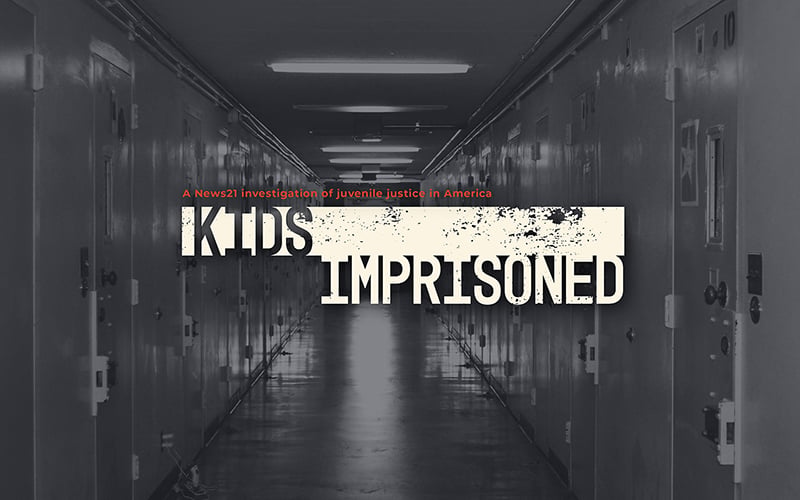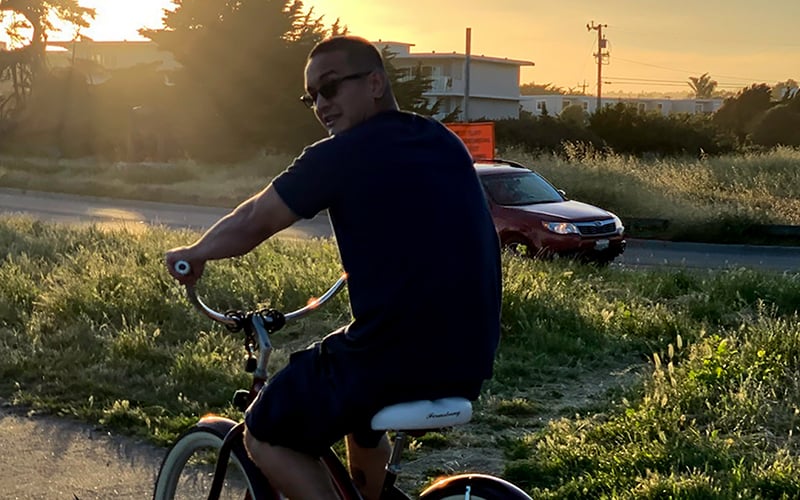
Edgar Ibarra was released from prison in 2017. He now works for MILPA, a nonprofit organization in California focused on Latino leadership development, helping others keep from having the same experiences that he had. (Photo courtesy of Edgar Ibarra)
Teenagers and youth across the country commit the same types of crimes – carrying a weapon, drinking alcohol, smoking marijuana and fighting – but even as the number of incarcerated youth has declined, disparities affecting young people of color have continued to grow.
This overrepresentation of minority youth is only half of the picture, a study from the Centers for Disease Control and Prevention showed, along with other reports.
Youth of color account for 28% of the U.S. population in 2017, according to a study from the Pew Research Center. However, they represented 67% of offenders in residential placement, according to Office of Juvenile Justice and Delinquency Prevention.
Joshua Rovner, a senior advocacy associate for the Sentencing Project in Washington, D.C., said there isn’t a significant difference between the crimes committed by youth of different ethnicities. The overrepresentation of youth of color in the juvenile justice system originates from systemic inequalities.
“There are differences, but none of the differences are big enough to explain the differences in arrests,” Rovner said.
He said the disparity gets worse at every step through the juvenile justice system.
Nationally, Black youth are five times more likely to be detained or confined than white youth, the Sentencing Project reported. Native American youth are three times more likely and Latino youth are roughly two times more likely than white youth.

Dylan Sutter celebrates his sixth birthday in 2004 with his mother, Leslie Sutter, in Minnesota. Sutter speaks highly of her son, saying he took great care of his younger siblings. (Photo courtesy of Leslie Sutter)
Growing up in Rochester, Minnesota, Dylan Sutter said he always helped out his single mother, took care of his younger siblings, never got into trouble and dreamed of playing college basketball.
Today, after a long history with the juvenile justice system, the 21-year-old sits in a cell in the Faribault Correctional Facility, where he’s serving a five-year sentence for burglary.
“I never had problems with him when he was very young,” said his mother, Leslie Sutter. “He was never a troubled young man that I saw. But now when he describes things to me and he’s written me letters, he says, ‘Mom, I always felt like it was part of my future and my destiny to go to prison like my dad did.'”Experts point to many factors contributing to these disparities, including the disproportionate presence of police in communities of color.
Minority youth lack “the benefit of the doubt,” said Tanya Washington, a senior associate for the Annie E. Casey Foundation in Baltimore in its Juvenile Justice Strategy Group.
“I think (it’s) assuming that the behavior that (white youth) are engaged in warrants a call to their parents and a non-justice system resolution, versus youth of color, (which) almost by default involves police, in handcuffs, and a judge and a charge,” Washington said.

Dylan Sutter’s father, Thaddius Ledford, was incarcerated in the Wisconsin corrections system when Dylan was growing up. Sutter says he always felt like he would follow his father’s footsteps and land in prison at some point. (Photo courtesy of Leslie Sutter)
Marcy Mistrett, the CEO of Campaign for Youth Justice in Washington, D.C., says some young people encounter law enforcement multiple times in a day: Near public housing. In schools. At a bus station. By basketball courts.
“I think we just forget how pervasive law enforcement is in the lives of Black and brown children,” Mistrett said.
Adryann Glenn, 41, grew up in public housing in Herndon, Virginia. As a Black male in the U.S., he said, he felt targeted by law enforcement. He was arrested for the first time at age 14 for bringing a gun to school.
“I’m still very conscious of (the fact that) I can’t make one mistake – and that’s inhumane to think that you can’t make a mistake in life – but the simplest mistake because of my criminal past, I go directly to jail, and it’s been that way since I was 14 years old,” Glenn said.
Glenn, now a criminal justice advocate, said his story is not unique.
“I don’t have any friends – literally none of the guys I work with – there’s not any of us who have not been incarcerated for one reason or another, or detained at least,” he said.
Sutter said he, too, felt he had a “target on his back” as a minority student in a mostly white school. He once was suspended for arguing with a friend, and he noticed the punishments he received were harsher than white classmates were given.
“I felt in high school, the principal and the administration had their eye on me a little too much,” he said.
The presence of school resource officers often leads students into the justice system, known as the school-to-prison pipeline, for more arbitrary offenses.
“I made a lot of mistakes and I maybe earned that target on my back,” Sutter said. “But even when I thought I was doing the right thing and wasn’t involved in any trouble, I felt like they still were out to get me.”
Black youth are the most overrepresented minority group, according to the Sentencing Project. In six states – New Jersey, Wisconsin, Montana, Delaware, Connecticut and Massachusetts – they are at least 10 times more likely to be held, which is twice the national average.
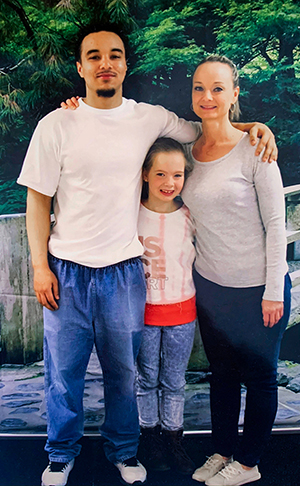
Dylan Sutter poses for a photo with his mom, Leslie Sutter, and sister, Olivia, at the Faribault Correctional Facility in Minnesota in March 2020. Dylan is serving a five year sentence for burglary. “I still suffer from guilt, even though I know I tried my best,” Leslie said. “But I look at it like, what could I have done better to have prevented this?” (Photo courtesy of Leslie Sutter)
Disparities continue to grow in some states.
Kentucky decreased the overall detention rate for youth by 20% from 2014 to 2017, but detentions of Black children grew by 30% in 2017, according to the Kentucky Juvenile Justice Oversight Council.
Even during the COVID-19 pandemic, when some detainees are being released to reduce their risk of infection, white youth are being released at higher rates than Black youth, a recent Annie E. Casey Foundation report found.
Black juveniles represent about 54% of youth transferred to the adult system, according to the Campaign for Youth Justice.
Rachel Antonuccio, a juvenile public defender in Johnson County, Iowa, represents juveniles facing charges in adult court. She said most of the children she represents are kids of color in a state the Census Bureau says is 85% white non-Hispanic.
“The initial charge is based on police discretion, and that’s how you start in adult court,” she said. “My concern is that racism in the police system is responsible for quite a bit of this, frankly. And then, racism across systems. That’s where it starts.”
Police officers and college students surveyed by the American Psychology Association found that “Black (children) were rated as more culpable than Latinos, and Latinos were rated as more culpable than Whites.”
Black youth treated differently
Black children as young as 13 have been viewed as adults, the report said.
“In other words, our findings suggest that, although most children are allowed to be innocent until adulthood, Black children may be perceived as innocent only until deemed suspicious,” it stated.
Kameron Johnson, the chief juvenile public defender in Travis County, Texas, said perception of age is important to consider.
Black children have “the same gestures and mannerisms, say, that a white child would, but (officers) are seeing them in different ways,” he said.
Johnson said Tamir Rice, a 12-year-old killed by Cleveland police in 2014 while playing with a pellet gun, was prejudged by officers responding to a 911 call of a man brandishing a gun.
“They pulled a gun on him,” Johnson said. “The officer viewed him as threatening. And then the response (was), ‘Oh, he looked older than he was.'”
Rice’s death, at the hands of law enforcement, is one of many that inspired the Black Lives Matter movement, which continues to gain traction through protests and national efforts to reform police departments.
The adultification of juveniles particularly affects youth of color, said Samantha Mellerson, the chief of strategy and impact at The W. Haywood Burns Institute, which works towards eliminating racial and ethnic disparities.
“In a training session once, somebody (pointed out) the Dennis the Menace cartoon,” Mellerson recalled. “What would that look like if that was the Black boy? Totally different.”
Mellerson said assumptions about children of color are unfair and that minority kids feel they can’t be kids.
Glenn said he grew up knowing police would assume he was older than he was.
“Where I come from, in my type of neighborhood, you’re an adult as soon as you’re over 5 foot, 5 inches, that’s the way the police deal with you,” Glenn said. “They don’t deal with you like a child, they deal with you like an adult.”
Latino juveniles also face adultification, according to a 2016 report from the Northwestern Journal of Law & Social Policy, which stated, “Black and Latino boys were more likely than white boys to be seen as older by law enforcement and legal actors.”
Black and Latina girls are not exempt either. Minority girls have a higher likelihood of being incarcerated compared with white girls.
Black girls made up 34% of youth in U.S. detention facilities in 2019, while Hispanic girls accounted for 22%, according to the U.S. Department of Justice. In 2015, more than 6 out of every 10 females in residential placement were minorities.
Iliana Pujols, 22, was expelled from high school after getting into an altercation with another girl. Pujols said police officers never asked her side of the story.
“The immediate assumption was that I was the aggressor because I was a little bit bigger than the other girl,” said Pujols, who is Latina. “They thought I was over 18, but I’ve always presented myself as a very mature person, and an older person, so nobody knew that I was 16 years old at the time.”
Latino and Native American youth encounter unique biases within the juvenile justice system. Their identities are underreported and misrepresented in data, and they often face prejudice from law enforcement, experts said.
Hispanic youth on average are detained about two times more often than white youth, according to the Office of Juvenile Justice and Delinquency Prevention.
Edgar Ibarra, 27, said he felt police targeted him and presumed he was in a gang because of his Chicano Indigenous identity.
Growing up fatherless, and with his mother constantly working, Ibarra said he had little guidance. Watsonville did not have enough youth services, Ibarra said, and he struggled to find a path in life.
“The people that we looked up to were just kind of like the guys hanging out around our blocks around the neighborhood,” Ibarra recalled.
He was convicted for the first time at the age of 15 in Santa Clara, California, of assault and robbery. He was in the Preston Castle Reform School from 2008 to 2013.
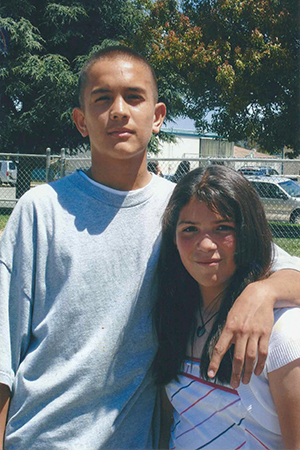
Edgar Ibarra of Santa Cruz County, California, was convicted for the first time at 15. Here Ibarra poses with his cousin in 2007, one year before his sentence to a juvenile facility. (Photo courtesy of Edgar Ibarra)
Although Ibarra said he was not in a gang at the time, the juvenile justice system always treated him like he was. Police often would approach him and his friends if they were walking in a group, performing “tattoo checks” and taking down personal information.
When he was 12, Ibarra was stopped by a police officer, asked to take off his shirt so his gang-related tattoos could be photographed – but he had none.
“They’d put your name on there, they would determine what gang you were already going to be a part of and begin the whole process,” he said.
Presumed gang affiliation is a prejudice most Latino youth face, said Washington, D.C., attorney Julie Swaney, which often is based on the assumption that a Latino or Hispanic surname means gang involvement.
“That already stigmatizes the child who may not be involved at all in any type of gang activity,” Swaney said.
Ibarra said his mother, who wasn’t a citizen at the time of his conviction, was barely involved in the legal process.
“She never spoke up in court because she was scared that they might question her and she might get deported,” he said. “I thought that she was just the kind of the normal, soft-spoken … Mexican mother (who) just doesn’t want to change anything.”
Today, Ibarra works for Motivation Individual Leadership for Public Advancement (MILPA), an organization staffed by formerly incarcerated people whose mission is to “cultivate” change-makers. His work focuses on helping Latino youth avoid or navigate the justice system, using his own experiences to provide insight.
In Utah, Montana and Pennsylvania, Latino youth are more than three times as likely to be held in placement than white youth, and in Massachusetts they’re more than seven times as likely, according to the Sentencing Project.
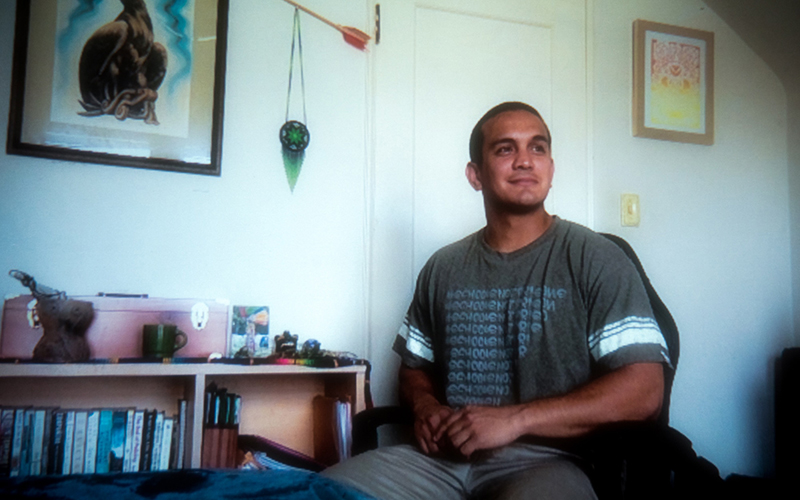
Edgar Ibarra, pictured in his home in Watsonville, California, was released from prison in 2017. He now works for MILPA, a nonprofit organization in California focused on Latino leadership development, helping others keep from having the same experiences that he had. (Portrait taken remotely by Layne Dowdall/News21)
Like Sutter, Ibarra said going to jail felt like the path he was destined to take.
“I thought (going to jail) was OK, it was normalized,” Ibarra said. “It should’ve never been normalized, it should’ve never been internalized nor should ever have been OK, but growing up at the time, that’s what it was.”
Jaime Arredondo, executive director of CAPACES Leadership Institute, an organization focused on leadership development within Latino communities, said he worries about the effect of disproportionate incarceration has on Latino youth.
“We’re losing our youth, we’re losing our workers, we’re losing a brother, a sister, a potential entrepreneur, a taxpayer,” he said.
Statistics on Latinos ‘unreliable’
No uniform system of data collection exists to identify youth as Hispanic and Latino when they’re detained, according to Melissa Sickmund, director of the National Center for Juvenile Justice. Some systems, but not all, include multiracial as an identifier.
Rovner said data surrounding incarceration rates of Latino and Native youth can be unreliable. Often Latino or Hispanic youth are categorized solely as white, and Native youth are identified as Latino or Hispanic.
“The fact that the data is aggregated, or disaggregated, and just grouped in such a way that each kid only gets one ethnicity,” said Rovner from the Sentencing Project. “Well, half of Native youth in this country are also Latino, but they get categorized only as one or the other.”
Data from the Office of Juvenile Justice and Delinquency Prevention shows Native American youth are nearly three times as likely to be detained or committed than white youth, but Native Americans account for less than 2% of the U.S. population, according to the Census Bureau.
“Native American youth are bearing the brunt of this in an epic way as well,” said Tshaka Barrows, CEO of the W. Haywood Burns Institute. “But it’s rarely discussed.”
A 15-year-old boy from Wyoming received 20 years in prison after bringing two loaded guns to school when he was 14. He pled guilty to assault and possession of a firearm with unlawful intent. Dale Warner, originally from the Lakota Sioux Tribe on the Cheyenne River Reservation in South Dakota, faced difficult circumstances growing up, according to his adoptive family.
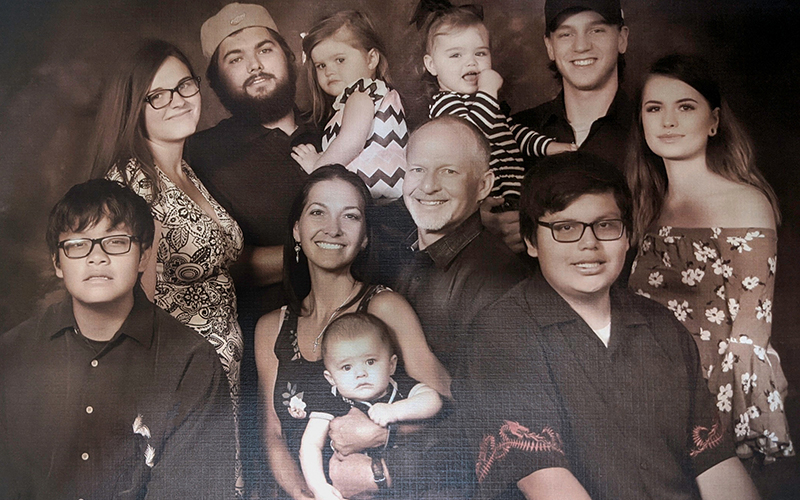
Dale Warner, bottom left, with his adoptive family in 2018. He lived with 20 foster families before the Warner family adopted him and his brother, bottom right, in 2015. (Photo courtesy of Scott Warner)
Warner developed a fetal alcohol syndrome disorder as a baby, a common issue in Native American communities plagued by higher rates of alcoholism and a lack of preventative resources, a BMC Public Health study stated.
His adoptive father, Scott Warner, said his son met a harsher judicial process than white youth who had committed similar crimes in Gillette.
“I honestly think race had something to do with it, because it just seems weird how the other cases, and I’m going to say there’s probably three or four of them, never saw the light of day as far as adult court or any of that,” Scott Warner said. “Yet my son all a sudden has 20 years in prison.”
Swaney, the Washington attorney who works on the Criminal Justice Act Panel and the Juvenile Delinquency Panel, said the solution is preventing kids from ever getting to the courthouse door.
“If they need to be in the court system because of the severity of the offense or because there just has been repetitive activity of that nature, then we need to focus more on what types of things are actually effective at preventing or solving some of those problems,” she said.
LaTasha DeLoach, co-chair of the Iowa Disproportionate Minority Contact Committee, said it is important to use data to create solutions for disparities and create positive results for minority communities.
“I really believe the answer is always there.” she said. “It’s about us finding it and finding the things that are impacting kids that are ending up in this space.”
Mikhayla Hughes-Shaw is a Murray Endowment fellow.
This report is part of Kids Imprisoned, a project produced by the Carnegie-Knight News21 initiative, a national investigative reporting project by top college journalism students and recent graduates from across the country. It is headquartered at the Walter Cronkite School of Journalism and Mass Communication at Arizona State University.
